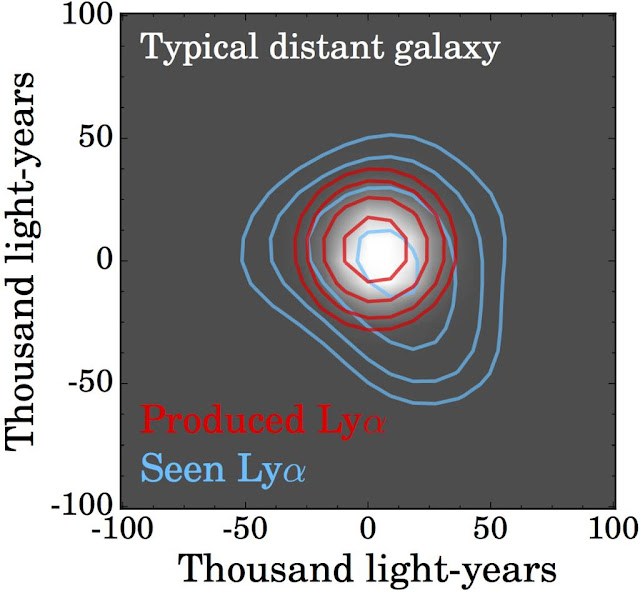The figure shows some of the observations conducted with the INT and
with the UKIRT in Hawaii of one of the (almost 1000) young Milky Way
type galaxies in the very
early Universe. The results allowed astronomers to measure where, and
how many, Lyman-α photons were produced (indicated by the red contour
lines), and then compare with those that have actually escaped (blue
contour lines) these distant galaxies. The results reveal large haloes
of Lyman-alpha photons that struggled to escape, while the vast majority
of these photons never make it out at all. Credit: J. Matthee/D.
Sobral. Large format: JPG.
Astronomers from the Universities of Lancaster in the UK and Leiden in
the Netherlands report the discovery of giant halos around early Milky
Way type galaxies which are composed of Lyman-α photons that have
struggled to escape them.
In order to understand how our own Milky Way galaxy formed and evolved,
astronomers can use observations of distant galaxies. As their light
takes billions of years to reach us, telescopes can be used as time
machines, as long as we have a clear time-travelling indicator to
pin-point the distance.
However, when we travel more than 11 billion years into the past, there
is only one major photometric feature our telescopes can identify: Lyman
α.
Jorryt Matthee comments: "Newly born stars in very distant galaxies are
hot enough to break apart hydrogen in surrounding clouds of gas, which
then shine brightly in Lyman-α light, in theory the strongest of such
features observable in a distant galaxy.
Yet, in practice, Lyman-α photons struggle to escape from galaxies as
gas and dust block and diverge their travel paths. As a consequence,
these photons can escape some galaxies more easily than others, although
the details are not well understood."
Astronomers developed a unique experiment using the Isaac Newton
Telescope (INT) to look at almost 1000 very distant galaxies. They
surveyed the sky using the Wide Field Camera (WFC) and a custom-made
filter in order to measure where, and how much, Lyman-α emission is
produced, and where it comes out of galaxies.
David Sobral says "We have used dozens of dedicated nights on the INT
with our own narrow-band filter in order to understand how many Lyman-α
photons escape and from which galaxies. We looked back in time 11
billion years, essentially the limit where we can still use multiple
features to identify distant galaxies and study them in detail. Most
importantly, we were able to predict accurately how many Lyman-α photons
were
effectively produced in each galaxy and where this happened. Then we
compared them with the ones that actually reach the INT."
The results show that only 1-2% of those photons escape from the centres
of galaxies like the Milky Way. Even if we account for all the photons
at a large distance from the centre, less than 10% escape. In other
words, all galaxies forming stars in the distant Universe are surrounded
by an impressively large halo of Lyman-α photons, which we can only
detect if we conduct extremely deep observations.
On the other hand, galaxies that are bright in Lyman-α light typically
are of much lower mass than the Milky Way and have a higher escape
fraction.
Astronomers expect that using the James Webb Space Telescope will be
able to extend these studies to even higher look-back times, opening up a
new window into the study of galaxy formation and evolution. Studying
how escape fraction evolves with redshift can tell us about the kind of
stars producing these photons, and the properties of interstellar and
intergalactic gas.
More information:
Jorryt Matthee, David Sobral, Iván Oteo, Philip Best, Ian Smail, Huub Röttgering and Ana Paulino-Afonso, 2016, "The CALYMHA survey: Lyα escape fraction and its dependence on galaxy properties at z = 2.23", MNRAS, 458, 449 [ ADS ].
David Sobral, Jorryt Matthee, Philip Best, Andra Stroe, Huub Röttgering, Iván Oteo, Ian Smail, Leah Morabito, Ana Paulino-Afonso, 2017, "The CALYMHA survey: Lyα luminosity function and global escape fraction of Lyα photons at z=2.23", MNRAS, 466, 1242 [ Astro-ph ].
"Photons struggle to escape distant galaxies", RAS press release PR 17/1, 10 January 2017.
Source: Isaac Newton Group of Telescopes
